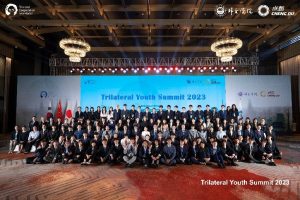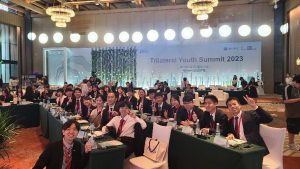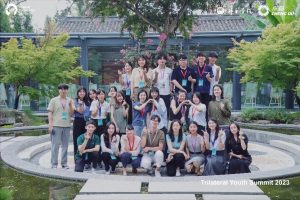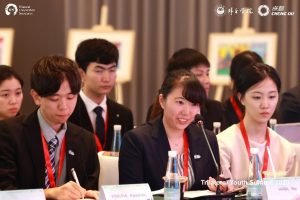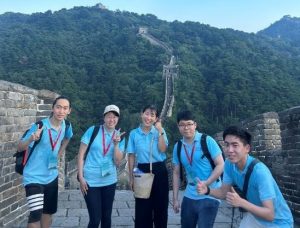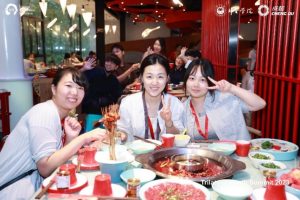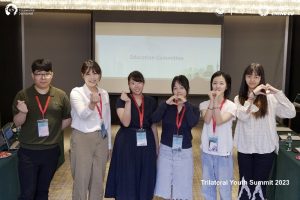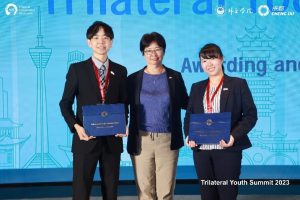Report on the Trilateral Youth Summit (TYS) 2023October 11, 2023
From August 13th to 22nd, I participated in the Trilateral Youth Summit (TYS) 2023 in Beijing and Chengdu, China, organized by the Trilateral Cooperation Secretariat (TCS). I would like to provide a brief overview of the summit and its activities.
Summit Overview
TYS 2023 comprised 100 university and graduate students from Japan, China, and South Korea (CJK), with each country contributing approximately 33-34 participants. Throughout the 10-day residential program, we discussed issues in which the role of youth is highly anticipated. Besides, we had the opportunity to visit relevant institutions and engage in cultural experiences. Students from each country were initially categorized into four delegations: Japan, China, South Korea, and TCS. Subsequently, we were assigned to one of the four committees focusing on education, cultural tourism, sports, or health. Within these committees, representing the positions of their respective delegations, we collaborated to draft a joint statement to be adopted at the simulated Trilateral Youth Summit.
- Group Photo of All Participants
- Members of the Japanese Delegation
Activities in the Committee
I was assigned to the Japanese delegation and became a member of the Education Committee. Each committee had a designated chair country, and Japan held the chair position in the education committee. Therefore, serving as the head of the Education Committee of the Japanese delegation, I was assigned the role of the Education Committee Chair. Within the committee, each delegation first presented the content they wanted to incorporate into the joint statement, and then, through discussions, we collectively crafted the joint statement. The key points included in the joint statement by the Education Committee are as follows:
- Further enhancement of the CAMPUS Asia Program (expansion of participating universities and fields of study, etc.)
- Establishment of an international exchange program for middle and high school students among CJK (TEEN Asia Program) including homestays and short-term study programs in summer/winter.
- Establishment of an environmental education program (CLIMATE Asia Program) focusing on climate change issues.
- Establishment of a history education program (PEACE Asia Program) to promote mutual understanding through dialogue.
Particularly, the fourth point generated discussions regarding the program’s content. It was eventually included in the joint statement under the recognition that learning each country’s perspectives through dialogue is crucial for peacebuilding in East Asia. On the day of the simulated Trilateral Youth Summit, I presented the educational part of the joint statement as the chair of the Education Committee.
- Members of the Education Committee
- Presentation at the Simulated TYS
Cultural Experiences and Others
During TYS, besides preparing for the simulated Trilateral Youth Summit, we engaged in various activities. In the first half of the summit, we learned about international relations and cultural exchange among CJK through panel discussions by diplomats from each country and lectures by professors. On the fourth day, we visited the Ministry of Ecology and Environment of the People’s Republic of China and deepened our understanding of the importance of international cooperation in solving environmental issues.
As part of our cultural experiences, we visited some tourist sites in Beijing and Chengdu. In Beijing, we climbed the Great Wall. It was a challenging experience due to the scorching heat. Still, with the support of my fellow participants, I managed to reach the Great Wall, which became an unforgettable memory. Additionally, we savored the authentic taste of Beijing duck at the restaurant where it originated. We explored various tourist destinations in Chengdu as well. Chengdu is renowned as the city of pandas, and we could feel the abundant love for pandas with panda monuments and illustrations scattered throughout the city. When we visited the panda base, we could see many adorable pandas. We also deepened our understanding of Chinese history by visiting places such as the Wuhou Shrine dedicated to Liu Bei and Zhuge Liang, the Jinsha Site Museum, and the Dujiangyan Irrigation System, a water conservancy facility from ancient China. Sichuan Province, where Chengdu is located, is famous for its spicy food. Therefore, we also experienced authentic hotpot. It was very spicy but so delicious.
- At the Great Wall
- Hotpot Experience
Reflection
As I write this report, I find myself reminiscing about the activities from the first day. The ten days spent interacting with fellow young people from Japan, China, and South Korea were irreplaceable. Since I had never led discussions or presented in front of an audience of over a hundred people in English, I was filled with anxiety and wondering if I could handle it when I was appointed as the chair of the Education Committee. However, with the warm support of my teammates, I managed to accomplish it. I would like to express my gratitude to all the participants, especially the members of the Japanese delegation and the Education Committee.
Through my participation in TYS, I have come to recognize the value of people interacting in person. The three countries of Japan, China, and South Korea are facing challenges that are difficult to resolve. However, even in such circumstances, we were able to foster friendships beyond borders through mutual exchange. No matter how difficult the challenges we face, we cannot move the locations of our countries. That is why it is crucial to maintain channels of dialogue, listen to each other’s opinions, and find common ground, even if our positions do not necessarily coincide. I have learned the importance of this diligent work through the discussion in TYS.
As one of the alumni of TYS, as a participant in the Campus Asia Program at the University of Tokyo, and as a member of the youth who will shape the future, I hope to contribute to further build on the history of cooperation and exchange that Japan, China, and South Korea have woven together.
- Members of the Education Committee from the Japanese Delegation
- With Mari Takada, Consul-General of Japan in Chongqing
(HARA Rio)
Disclaimer: This report reflects the author’s personal views and does not represent the official stance of their institution.


